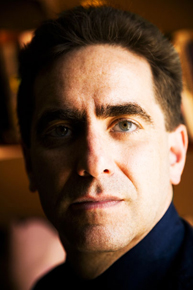Monumental research: political symbolism in post-Soviet Russia
Monumental research: political symbolism in post-Soviet Russia McGill University
User Tools (skip):
Monumental research: political symbolism in post-Soviet Russia
With everything else going on in the world on a recent weekend, the rioting in the streets of Tallinn, Estonia, was notable not for the number of arrests it provoked—800—or even its death count—one. The civil unrest in the streets of the Estonian capital during the last weekend of April was remarkable because it was Russians who were doing the rioting, and it was all in the name of a 6-foot monument: a statue of a World War II-era Red Army Soldier.

The importance of symbolic politics in Russia has risen, says Human geography Professor Benjamin Forest.
Claudio Calligaris
"In the post-Soviet period," said Associate Professor of human geography Benjamin Forest, "we've seen a tremendous importance of symbolic politics that stems from a crisis in Russian identity. And we're seeing that play out in attachment to monuments, memorials and language."
As markers of history and memory, monuments are meant to educate people about important events or figures from the past. At first glance, especially in North America, they are unmoving, static and altered only by the elements.
But because of their power, in some cultures and in certain periods, they have often been manipulated to promote a specific reading of the past to reinforce a particular notion of national identity.
When the Soviet Union collapsed in 1991, the shattering of the country's political structure and its decline in world-wide power were followed by a profound loss of political, national and personal identity.
Since Russians found themselves at a critical juncture, politicians in the changing country tried to create a new national identity to reflect the new era.
Professor Forest studies how politicians seeking power and support transformed key monuments and memorials in Moscow in the 1990s from Soviet symbols to Russian symbols.
Forest found that the new identity created by politicians was surprisingly similar to the previous one.
"There's been a resurgence of nostalgia for the Soviet period, particularly as life has gotten more difficult materially and Russia has lost its super-power status," said Forest.
This past July, Forest left Dartmouth College for McGill to continue his research into how race, ethnicity and nationality are constructed by political institutions, and how they are influenced by geographical space.
He has been working on the monument project since 1999 with his wife, Juliet Johnson, of the Department of Political Science. Indeed, the idea for the project came from Johnson's travels in Russia.
"She described amazing changes to the monuments and memorials in the country during the post-Soviet era: old ones were altered, hauled away or dumped, while new ones were being erected," recalled Forest.
Together, they analyzed how political leaders used public space to shape Russia's direction and to influence the population's sense of itself.
According to Forest and Johnson, in the 1990s, political leaders in Moscow built monuments that had "symbolic capital"—symbols that reflected historical events venerated by the public.
Although certain elements of the Soviet period, such as the Communist Party or the command economy, had been clearly disavowed, politicians in the 1990s understood that Russians looked back to World War II with pride, as exemplified by the Victory Park complex.
Forest and Johnson studied the complex, which commemorates the "Great Patriotic War." Originally planned in 1957 during the Khrushchev era, the complex was completed and transformed by the mayor of Moscow in 1995. Although overt symbols of Soviet times such as the hammer and sickle were removed from the original designs, the modified memorial, through imagery as well as sheer size, still reflects the grandeur of communist times.
Now occupying the centre of the site are the new additions to the monument, including a towering obelisk adorned with Nike, the goddess of victory, and a large statue of St. George slaying the dragon. The latter acts as a symbol of religion, of the victory over Nazism, and of the Russian nation, as St. George is the patron saint of Moscow.
To further distance the park complex from the nominally atheist Soviet times, three religious shrines were built. A grand Orthodox cathedral with a gold dome now holds a prominent position at the front of the complex. Additionally, according to Forest, a mosque and a synagogue have been positioned at the rear of the memorial site.
So, while the rest of the world may still carry distinct notions of what it means to be Russian, the Russians themselves are fighting for monuments to the national identity they once knew.
Andrei Liveanu is a WARM-SPARK writer. WARM-SPARK (Writing About Research at McGill-Students Promoting Awareness of Research Knowledge) is a program Supported by the Vice Principal (Research Office), Associate Vice Principal (Communications), the faculties of agricultural and environmental sciences, arts, engineering, medicine and science.
See www.spark.mcgill.ca for more information and articles.

